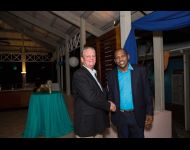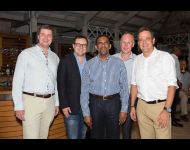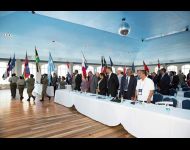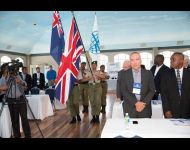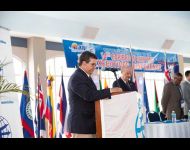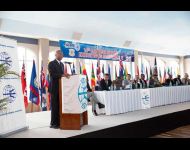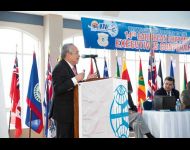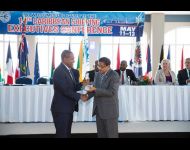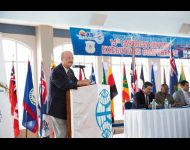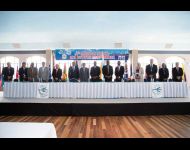Terminal operating systems
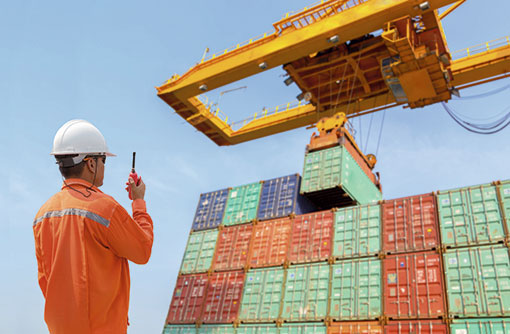 According to a 2015 report by Navis, the world leader in TOS software, it is now possible to eliminate an estimated US$ 17 billion of waste by adopting more integrated technology platforms for terminal and port operations. The report says this can only be achieved through strong leadership across the industry and, in some cases, a change in mindset.
According to a 2015 report by Navis, the world leader in TOS software, it is now possible to eliminate an estimated US$ 17 billion of waste by adopting more integrated technology platforms for terminal and port operations. The report says this can only be achieved through strong leadership across the industry and, in some cases, a change in mindset.
Automation
TOS software is becoming more complex as larger ships bring in more containers, causing bottlenecks in ports and challenging the existing shoreside infrastructure to maintain productivity. Automation is one way to solve this problem; but it makes operations much more complex. In a conventional terminal, it is people who decide how to deal with container movements. With automation, all these decisions are made by software. For many, this can be a huge adjustment.
By investing in automated systems, a terminal can increase its container density, minimize unnecessary movements and boost productivity. The more that human interaction can be reduced, the greater the scope for improved productivity.
Increased automation is a challenge both for terminal operators and for TOS designers; but it can reduce costs while increasing safety and sustainability. Some examples of automation already in widespread use are optical character recognition (OCR) of vehicles, containers and security access for automated gate systems; weighbridges and scales on cranes; GPS systems on equipment; position detection systems; and use of radio frequency identification systems.
However, as Chuck Schneider, the general manager, Americas, for Navis, points out: “It is important for terminals to understand the behavior of the TOS user in an automated terminal environment and how they can do their jobs effectively while using the capabilities of the software. What we are finding is that when the TOS makes a decision in an automated terminal environment, the user will want to second-guess that decision and try to override the system. They end up disrupting many other things upon which that decision was based, driving performance down.”
Navis, established in 1988, is the largest TOS producer in the world. Part of Cargotec Corporation, it developed the first TOS in the late 1980s and now provides software in over 280 terminals worldwide. Its pioneering SPARCS system paved the way for container handling efficiency. The latest generation of software is Navis N4.
Navis is used at a handful of ports in the Caribbean: Freeport Bahamas, Port Authority of Trinidad and Tobago and at Arawak Port Development in Nassau. Navis has also been in place for a decade in Cartagena, Colombia.
“A computerized TOS system really becomes valuable once a terminal hits 10,000 teu,” said Mr Schneider. “Then they need to start integrating it into the greater supply chain and with operational processes like gate systems that utilize EDI messaging. Up until that point they can really handle things with manual processes.”
As the terminal grows, the TOS optimizes such processes as equipment use, loading and discharging of vessels, and yard planning.
One of the biggest challenges for TOS development is dealing with changes in the industry. As vessels continue to grow in size and capacity, customer expectations rise and budgets shrink, while container terminals around the world are under pressure to optimize their operations and improve productivity.
“The TOS needs to be the facilitator of managing these challenges so terminals can meet the demands of their customers,” said Mr Schneider. “The industry is also recognizing the need for shipping lines and terminal operators to increase their collaboration by sharing data through tools. We are seeing more work being done to develop technological cloud-based tools to help facilitate collaboration and improve the flow of goods. A further trend is the need to deal with the implementation of SOLAS. This is affecting all TOS providers.”
From 1 July 2016 an amendment to SOLAS Regulation VC1/2 makes it mandatory for the gross weight of a container to be verified before it can be loaded onto a vessel.
Mr Schneider concluded: “Terminal operators need to catch up with everything that is available in process automation technologies, utilizing best practices for process improvement and efficiency. Some of the big terminal operators now have dedicated people and teams whose job it is to access the terminal’s operational performance with six-sigma practices.”
Nervous system
Harvey Bauer, director of marketing and contracts at Tideworks, probably the most widely used TOS in the Caribbean, acknowledges that terminal operators are looking to push up productivity using the same or fewer resources. They want more sophistication in systems at a cost-effective price, he says.
“Helping our customers control their costs through the effective implementation of technology is one of our biggest challenges and remains a key driver of our developments and innovation,” said Mr Bauer.
“Terminal operators of all sizes can reap tremendous benefits from the implementation of a commercial TOS. Even very modest-sized terminals can substantially reduce the amount of manual processes, increase the accuracy of data, improve reporting capabilities, enhance communication with business partners and, in general, streamline their operations.”
Tideworks software is used at Kingston Wharves Ltd (Jamaica), Manzanillo International Terminal (Panama), Barranquilla Container Terminal (Colombia), Santa Marta International Container Terminal (Colombia), the Dole Food Company (Guatemala, Honduras and Costa Rica) and Port Lafito (Haiti). It is also expected to be implemented in Puerto Rico at the TOTE Maritime and Crowley terminals.
“The TOS is intended to be the central nervous system of the terminal’s operations,” said Mr Bauer. “Supplementary technologies, such as automated data capture tools or real-time tracking systems, may be added and integrated within the TOS as the terminal grows. So, while the correct mix of technology at any particular stage in a terminal’s evolution boils down to a business decision, implementation of a core TOS is fundamental from the onset.”
Mr Bauer says automation and optimization continue to be the most often requested TOS features from customers. “We have made some tremendous developments in recent years in these areas, culminating with a recently completed project at MIT-Panama, to fully support their use of automated stacking cranes (ASCs). Additionally, we’re nearing completion of a project in support of the new, highly automated Tuxpan Port Terminal in Mexico.
“Another current trend in the market place involves cloud computing, on-demand software, or Software as a Service (SaaS). Many terminal operators seek technology solutions that not only advance their operational and financial goals but allow them to do so with a minimal IT footprint and overhead. More and more, we see the ability of a TOS provider to offer a cloud-based or SaaS solution as an important factor in the decision-making process.”
Future-proof
The TOS has been a key feature in many ports since the 1980s, but to a large extent it has always relied on manual input of data. Data input methodology is changing faster today than ever before, with OCR and GPS tracking becoming more normal.
Choosing the right TOS is a key decision for the port. There is a wide choice of options, all designed for specific purposes but also generally customizable to each port’s needs. There are very few off-the-shelf packages. With the decision to roll out taking from six to 12 months of complex testing of the port’s existing systems, making the right initial decision is crucial, along with making the whole system as future-proof as possible.
What else does the future hold for the TOS industry? Mr Bauer said: “We predict the pursuit of the correct technology mix will continue to be the goal for marine and intermodal terminals as they work to get the greatest benefit out of limited resources and assets. Increasing pressure on the supply chain to work more efficiently will drive operators to make technology decisions based on gaining the most value out of their investments.
“The TOS has a growing role in this as it is the centerpiece to a terminal’s technology suite. Systems and hardware are becoming more complex yet more highly integrated. More than ever, the next-generation TOS will require a strong marriage between technology and operations. Over the next 10 to 20 years we feel the term ‘customer’ will diminish. Instead, we’ll see terminal operators and technology providers engaged in strong, mutually beneficial partnerships.”
Modular packages
TOS systems are generally designed as modular software packages that can be extended or modified to suit specific situations. For marine terminals, the most frequently used Tideworks modules are:
- Mainsail Vanguard (the core TOS)
- Forecast (web interface for the terminal’s customers)
- Spinnaker Planning Management System (graphical yard and vessel planning)
- Traffic Control (management of container handling equipment).
Tideworks core can easily be augmented by additional modules to enhance visibility, operational control and productivity. These include:
- GateVision (gate operating system and gate automation platform)
- Terminal View (3D data visualization tool).
GateVision can be seamlessly integrated with OCR and other data capture solutions to automate truck movements and streamline gate operations.
Within Navis N4 TOS various optimization modules are available:
- Expert Decking (to maximize yard space utilization, equipment availability and location and best slot allocation)
- Equipment Control (manages crane and RTG location and movements)
- Autostow (automatically generates stowage plans for the whole ship)
- Prime Route (minimizes unladen driving, increasing labor productivity and contributing to better asset utilization).
The most popular modules are Expert Decking and Equipment Control, which can be easily added. The main challenge is the ‘change management’ that needs to take place with the training of operators.
Issue 26 - October 2015 - January 2016
-
Harbour View
-
From the CSA President
-
Panama – new cranes for Manzanillo
-
Cartagena
-
Sail Cruising
-
Nicaragua Canal update
-
Cayman Islands
-
Port Lafito opening
-
Panama Canal update
-
Russbroker Caribbean market review
-
IT Investment
-
Contraband
-
CSA Diary - photo album
-
USA – new logistics center for Port Canaveral
-
Colombia – APM terminals in new joint venture
-
USA – new container terminal at Port Canaveral
-
Jamaica – KWL invests more
-
Cuba – cruise industry takes advantage of new political climate
-
Colombia – Puerto Bahía opens in Cartagena
-
Record passenger numbers for Carnival from New Orleans
-
Proposed Nicaragua Canal gets public vote
-
Panama Canal ‘on track for early 2016’
-
Tampa Bay gets security grant
-
Jumbo cruise ship heading to Florida
-
Clearing the Magdalena River
-
Boom in visitors to the region


